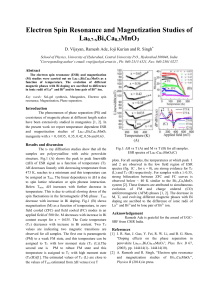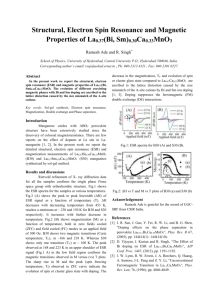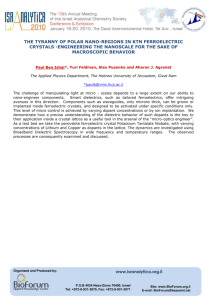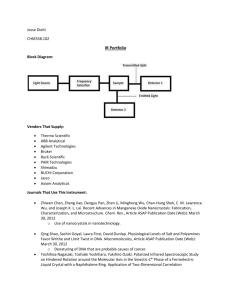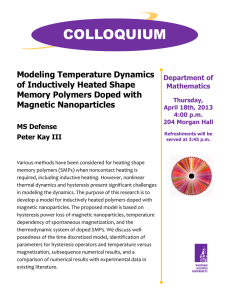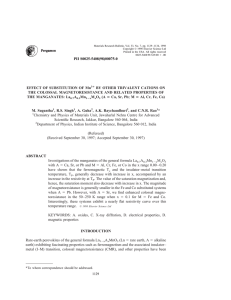Room temperature multiferroic properties of single-phase La – Ba Nb
advertisement
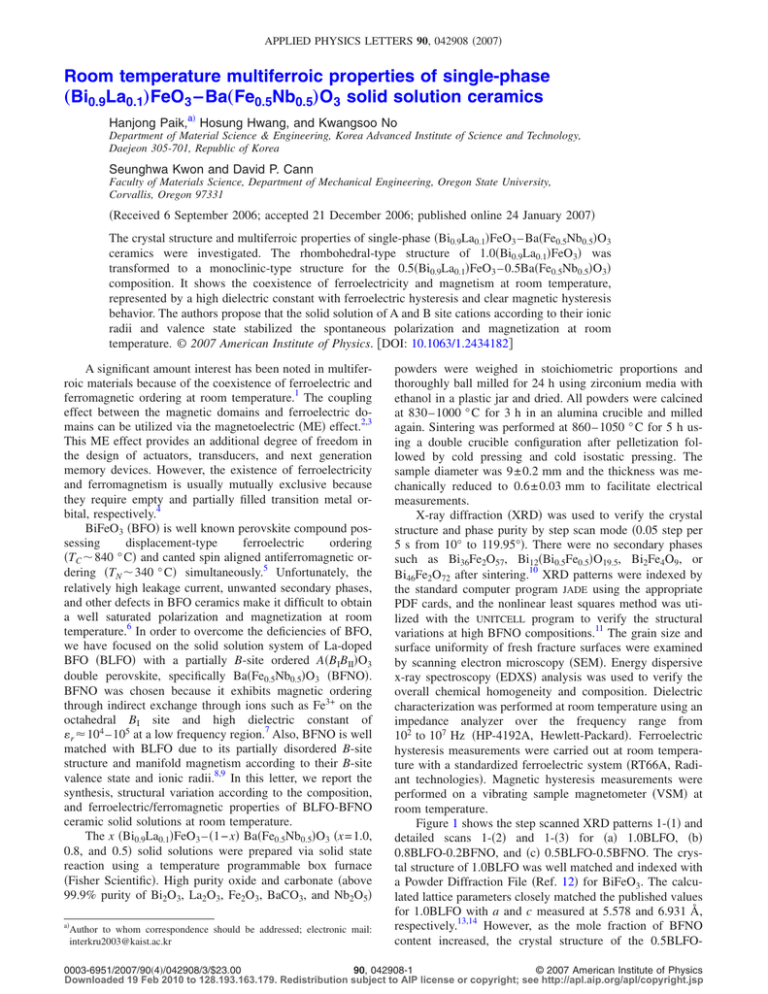
APPLIED PHYSICS LETTERS 90, 042908 共2007兲 Room temperature multiferroic properties of single-phase „Bi0.9La0.1…FeO3 – Ba„Fe0.5Nb0.5…O3 solid solution ceramics Hanjong Paik,a兲 Hosung Hwang, and Kwangsoo No Department of Material Science & Engineering, Korea Advanced Institute of Science and Technology, Daejeon 305-701, Republic of Korea Seunghwa Kwon and David P. Cann Faculty of Materials Science, Department of Mechanical Engineering, Oregon State University, Corvallis, Oregon 97331 共Received 6 September 2006; accepted 21 December 2006; published online 24 January 2007兲 The crystal structure and multiferroic properties of single-phase 共Bi0.9La0.1兲FeO3 – Ba共Fe0.5Nb0.5兲O3 ceramics were investigated. The rhombohedral-type structure of 1.0共Bi0.9La0.1兲FeO3兲 was transformed to a monoclinic-type structure for the 0.5共Bi0.9La0.1兲FeO3 – 0.5Ba共Fe0.5Nb0.5兲O3兲 composition. It shows the coexistence of ferroelectricity and magnetism at room temperature, represented by a high dielectric constant with ferroelectric hysteresis and clear magnetic hysteresis behavior. The authors propose that the solid solution of A and B site cations according to their ionic radii and valence state stabilized the spontaneous polarization and magnetization at room temperature. © 2007 American Institute of Physics. 关DOI: 10.1063/1.2434182兴 A significant amount interest has been noted in multiferroic materials because of the coexistence of ferroelectric and ferromagnetic ordering at room temperature.1 The coupling effect between the magnetic domains and ferroelectric domains can be utilized via the magnetoelectric 共ME兲 effect.2,3 This ME effect provides an additional degree of freedom in the design of actuators, transducers, and next generation memory devices. However, the existence of ferroelectricity and ferromagnetism is usually mutually exclusive because they require empty and partially filled transition metal orbital, respectively.4 BiFeO3 共BFO兲 is well known perovskite compound possessing displacement-type ferroelectric ordering 共TC ⬃ 840 ° C兲 and canted spin aligned antiferromagnetic ordering 共TN ⬃ 340 ° C兲 simultaneously.5 Unfortunately, the relatively high leakage current, unwanted secondary phases, and other defects in BFO ceramics make it difficult to obtain a well saturated polarization and magnetization at room temperature.6 In order to overcome the deficiencies of BFO, we have focused on the solid solution system of La-doped BFO 共BLFO兲 with a partially B-site ordered A共BIBII兲O3 double perovskite, specifically Ba共Fe0.5Nb0.5兲O3 共BFNO兲. BFNO was chosen because it exhibits magnetic ordering through indirect exchange through ions such as Fe3+ on the octahedral BI site and high dielectric constant of r ⬇ 104 – 105 at a low frequency region.7 Also, BFNO is well matched with BLFO due to its partially disordered B-site structure and manifold magnetism according to their B-site valence state and ionic radii.8,9 In this letter, we report the synthesis, structural variation according to the composition, and ferroelectric/ferromagnetic properties of BLFO-BFNO ceramic solid solutions at room temperature. The x 共Bi0.9La0.1兲FeO3 – 共1 − x兲 Ba共Fe0.5Nb0.5兲O3 共x = 1.0, 0.8, and 0.5兲 solid solutions were prepared via solid state reaction using a temperature programmable box furnace 共Fisher Scientific兲. High purity oxide and carbonate 共above 99.9% purity of Bi2O3, La2O3, Fe2O3, BaCO3, and Nb2O5兲 a兲 Author to whom correspondence should be addressed; electronic mail: interkru2003@kaist.ac.kr powders were weighed in stoichiometric proportions and thoroughly ball milled for 24 h using zirconium media with ethanol in a plastic jar and dried. All powders were calcined at 830– 1000 ° C for 3 h in an alumina crucible and milled again. Sintering was performed at 860– 1050 ° C for 5 h using a double crucible configuration after pelletization followed by cold pressing and cold isostatic pressing. The sample diameter was 9 ± 0.2 mm and the thickness was mechanically reduced to 0.6± 0.03 mm to facilitate electrical measurements. X-ray diffraction 共XRD兲 was used to verify the crystal structure and phase purity by step scan mode 共0.05 step per 5 s from 10° to 119.95°兲. There were no secondary phases such as Bi36Fe2O57, Bi12共Bi0.5Fe0.5兲O19.5, Bi2Fe4O9, or Bi46Fe2O72 after sintering.10 XRD patterns were indexed by the standard computer program JADE using the appropriate PDF cards, and the nonlinear least squares method was utilized with the UNITCELL program to verify the structural variations at high BFNO compositions.11 The grain size and surface uniformity of fresh fracture surfaces were examined by scanning electron microscopy 共SEM兲. Energy dispersive x-ray spectroscopy 共EDXS兲 analysis was used to verify the overall chemical homogeneity and composition. Dielectric characterization was performed at room temperature using an impedance analyzer over the frequency range from 102 to 107 Hz 共HP-4192A, Hewlett-Packard兲. Ferroelectric hysteresis measurements were carried out at room temperature with a standardized ferroelectric system 共RT66A, Radiant technologies兲. Magnetic hysteresis measurements were performed on a vibrating sample magnetometer 共VSM兲 at room temperature. Figure 1 shows the step scanned XRD patterns 1-共1兲 and detailed scans 1-共2兲 and 1-共3兲 for 共a兲 1.0BLFO, 共b兲 0.8BLFO-0.2BFNO, and 共c兲 0.5BLFO-0.5BFNO. The crystal structure of 1.0BLFO was well matched and indexed with a Powder Diffraction File 共Ref. 12兲 for BiFeO3. The calculated lattice parameters closely matched the published values for 1.0BLFO with a and c measured at 5.578 and 6.931 Å, respectively.13,14 However, as the mole fraction of BFNO content increased, the crystal structure of the 0.5BLFO- 0003-6951/2007/90共4兲/042908/3/$23.00 90, 042908-1 © 2007 American Institute of Physics Downloaded 19 Feb 2010 to 128.193.163.179. Redistribution subject to AIP license or copyright; see http://apl.aip.org/apl/copyright.jsp 042908-2 Appl. Phys. Lett. 90, 042908 共2007兲 Paik et al. FIG. 2. Scanning electron microscope of fracture surface 共a兲 1.0共Bi0.9 , La0.1兲FeO3, 共b兲 0.8共Bi0.9 , La0.1兲FeO3 – 0.2Ba共Fe0.5 , Nb0.5兲O3, and 共c兲 0.5共Bi0.9 , La0.1兲FeO3 – 0.5 Ba共Fe0.5 , Nb0.5兲O3. FIG. 1. 共Color online兲 X-ray diffraction pattern 1-共1兲 of sintered ceramics 共a兲 1.0共Bi0.9La0.1兲FeO3, 共b兲 0.8共Bi0.9La0.1兲FeO3 – 0.2Ba共Fe0.5 , Nb0.5兲O3, and 共c兲 0.5共Bi0.9La0.1兲FeO3 – 0.5 Ba共Fe0.5 , Nb0.5兲O3, and their detailed scans 1-共2兲 and 1-共3兲. 0.5BFNO solid solution showed a close match to a monoclinic-type structure. The unit cell parameters of 0.5BLFO-0.5BFNO were calculated as a = 8.052, b = 8.046, c = 8.069 Å, and  = 90.023 ° based on a Powder Diffraction File 共Ref. 15兲 for Ba共Fe0.33Nb0.67兲O3 as similar to the 1.0BFNO structure.7 Moreover, the detailed diffraction patterns of Figs. 1共b兲 and 1共c兲 clearly confirm the structural variations as a function of BFNO content. The calculated cell parameters are summarized in Table I. SEM images of fresh fracture surfaces in Figs. 2共a兲 1.0BLFO, 2共b兲 0.8BLFO-0.2BFNO, and 2共c兲 0.5BLFO0.5BFNO show a dense microstructure with well defined grains with no segregation of impurities. The EDXS analysis verified the chemical homogeneity of each sample. While the 共a兲 1.0BLFO and 共b兲 0.8BLFO-0.2BFNO samples had a grain size of about 1 – 2 m, that of 共c兲 0.5BLFO-0.5BFNO was enlarged to around 5 – 8 m. This grain enlargement could be responsible for the higher dielectric constant at the composition 共c兲 0.5BLFO-0.5BFNO. The frequency dependence of the relative permittivity and loss tangent is represented in Fig. 3共a兲 1.0BLFO, 3共b兲 0.8BLFO-0.2BFNO, and 3共c兲 0.5BLFO-0.5BFNO over the frequency range from 102 – 107 Hz at room temperature. The relative permittivity of 共a兲 1.0BLFO displayed a weak frequency dependence; however, the compositions 共b兲 0.8BLFO-0.2BFNO and 共c兲 0.5BLFO-0.5BFNO display significant frequency dispersion behavior which is likely due to nonstoichiometric effects.10 There is also large fluctuation in dielectric permittivity of 共c兲 0.5BLFO-0.5BFNO compared to the other samples, which may be attributed to space charge effects.16 We have also attempted to measure ferroelectric hysteresis at room temperature, as shown in Fig. 4. There is a formation of a well-defined nonlinearity in the hysteresis loop and a clear modification in the ferroelectric behavior with BFNO additions. The loops are not fully saturated due to the limitation of our measurement system. Also, ferroelectric hysteresis loops observed by Holland and Redfern11 did not show any saturation even at a temperature of 80 K.11 The as-prepared ceramic clearly demonstrated a spontaneous magnetization at room temperature, as shown in Fig. 5. Especially, the 共c兲 0.5BLFO-0.5BFNO composition represented a large enhancement in the magnetization. The coercive field 共Hc兲 and remanent magnetization 共M r兲 of each sample were 共a兲 10.737 kOe, 2.046 memu/ g, 共b兲 2.911 kOe, 64.813 memu/ g, and 共c兲 3.125 kOe, 539.090 memu/ g, respectively. Structural modifications with increased BFNO contents would likely be responsible for the observed enhanced magnetization at room temperature. Specially, the diminished magnetic properties of both Hc and M r in 1.0BLFO is due to the space-modulated spin structure, which is transformed to an arranged spin moment according to the monoclinic-type structure in the BFNO rich sample. A more detailed analysis of the magnetic properties as a function of temperature is in progress. In summary, the perovskite solid solution of BFNO with BLFO was demonstrated to exhibit room temperature multiferroism. By manipulating the A-site and B-site cation ordering in this complex perovskite, a spontaneous polarization and large magnetic moment could be achieved at room tem- TABLE I. Unitcell information calculated by least square method for 1.0共Bi0.9 , La0.1兲FeO3 and 0.5共Bi0.9 , La0.1兲FeO3-0.5 Ba共Fe0.5 , Nb0.5兲O3. Materials 1.0BLFO 0.5BLFO0.5BFNO Parameters Value Structure 95% confidence a 共Å兲 共Å兲 Cell vol. 共Å3兲 5.579 16 6.930 186.8170 0.025 9 a 共Å兲 b 共Å兲 c 共Å兲  共deg兲 Cell vol. 共Å3兲 8.052 8.046 8.059 0.000 56 0.002 11 0.005 72 Rhombohedral 0.000 27 0.001 01 Monoclinic Residuals 共sigmafit兲 5.4989 2.2476 90.023 0.031 39 522.115 0.374 4 Remarks Ref. 13 Ref. 14 Ref. 7 Ref. 8 Ref. 9 Downloaded 19 Feb 2010 to 128.193.163.179. Redistribution subject to AIP license or copyright; see http://apl.aip.org/apl/copyright.jsp 042908-3 Appl. Phys. Lett. 90, 042908 共2007兲 Paik et al. FIG. 3. 共Color online兲 Relative permittivity and loss tangent of the sintered ceramics 共a兲 1.0共Bi0.9 , La0.1兲FeO3, 共b兲 0.8共Bi0.9 , La0.1兲FeO3 – 0.2Ba共Fe0.5 , Nb0.5兲O3, and 共c兲 0.5共Bi0.9 , La0.1兲FeO3 – 0.5 Ba共Fe0.5 , Nb0.5兲O3 at a frequency range from 102 to 107 Hz. perature. An enhanced net magnetization was realized through an uncompensated antiferromagnetic moment owing to structural distortion and cation ordering. The ceramic undergoes a frequency dispersed dielectric property with a spontaneous polarization of 0.3 C / cm2 and magnetization of 539 memu/ g at room temperature. FIG. 5. 共Color online兲 Magnetization vs magnetic field hysteresis loop of the sintered ceramics 共a兲 1.0共Bi0.9 , La0.1兲FeO3, 共b兲 and 共c兲 0.8共Bi0.9 , La0.1兲FeO3 – 0.2Ba共Fe0.5 , Nb0.5兲O3, 0.5共Bi0.9 , La0.1兲FeO3 – 0.5 Ba共Fe0.5 , Nb0.5兲O3 measured at room temperature. Inset figure shows magnified M-H hysteresis for 共a兲 1.0共Bi0.9 , La0.1兲FeO3. This work was supported by the Korea Research Foundation Grant funded by the Korean Government 共MOEHRD, KRF-2006-C00135-I00713兲, and partially supported by the Ministry of Education in Korea 共project named “Brain Korea 21”兲. The authors also appreciated the VSM measurement to Sang-Hwan Park in Magnetic Thin Films Laboratory, KAIST, Korea. N. A. Spaldin and M. Fiebig, Science 309, 391 共2005兲. M. Fiebig, J. Phys. D 38, R123 共2005兲. 3 W. Prellier, M. P. Singh, and P. Murugavel, J. Phys.: Condens. Matter 17, R803 共2005兲. 4 M. M. Kumar, V. R. Palkar, K. Srinivas, and S. V. Suryanarayana, Appl. Phys. Lett. 76, 2764 共2000兲. 5 J. Wang, J. B. Neaton, H. Zheng, V. Nagarajan, S. B. Ogale, B. Liu, D. Viehland, V. Vaithyanathan, D. G. Schlom, U. V. Waghmare, N. A. Spaldin, K. M. Rabe, M. Wuttig, and R. Ramesh, Science 299, 1719 共2003兲. 6 Y. K. Jun, W. T. Moon, C. M. Chang, H. S. Kim, H. S. Ryu, J. W. Kim, K. H. Kim, and S. H. Hong, Solid State Commun. 135, 133 共2005兲. 7 N. Rama, J. B. Philipp, M. Opel, K. Chandrasekaran, V. Sankaranarayaran, R. Gross, and M. S. Ramachandra Rao, J. Appl. Phys. 95, 7528 共2004兲. 8 Sonali Saha and T. P. Shina, J. Phys.: Condens. Matter 14, 249 共2002兲. 9 Keitaro Tezuka, Kou Henmi, Yukio Hinatsu, and Nobuyuki M. Masaki, J. Solid State Chem. 154, 591 共2000兲. 10 X. Qi, J. Dho, R. Tomov, M. G. Blamire, and J. L. MacManus-Driscoll, Appl. Phys. Lett. 86, 062903 共2005兲. 11 T. J. B. Holland and S. A. T. Redfern, Miner. Mag. 61, 65 共1997兲. 12 PDF No. 20-0169 共unpublished兲. 13 V. R. Palkar, D. C. Kundaliya, S. K. Malik, and S. Bhattacharya, Phys. Rev. B 69, 212102 共2004兲. 14 I. Sosnowska, R. Przenioslo, P. Fischer, and V. A. Murashov, J. Magn. Magn. Mater. 160, 384 共1996兲. 15 PDF No. 17-0187 共unpublished兲. 16 M. Mahesh Kumar, V. R. Palker, K. Srinivas, and S. V. Suryanarayana, Appl. Phys. Lett. 76, 2764 共2000兲. 1 2 FIG. 4. 共Color online兲 Polarization vs applied voltage hysteresis of the sintered ceramics 共a兲 1.0共Bi0.9 , La0.1兲FeO3, 共b兲 0.8共Bi0.9 , La0.1兲FeO3 – 0.2Ba共Fe0.5 , Nb0.5兲O3, and 共c兲 0.5共Bi0.9 , La0.1兲FeO3 – 0.5 Ba共Fe0.5 , Nb0.5兲O3 measured at room temperature. Inset figure shows magnified P-V hysteresis for 共a兲 1.0共Bi0.9 , La0.1兲FeO3. Downloaded 19 Feb 2010 to 128.193.163.179. Redistribution subject to AIP license or copyright; see http://apl.aip.org/apl/copyright.jsp
